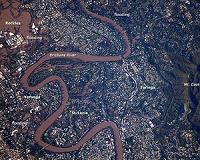 |
Washington DC (SPX) Jan 19, 2011 The first global simulation study of equatorial spread F (ESF) bubble evolution using a comprehensive 3D ionosphere model, SAMI3, has been demonstrated. The model self-consistently solves for the neutral wind driven dynamo electric field and the gravity driven electric field associated with plasma bubbles. Developed by Dr. Joseph Huba and Dr. Glenn Joyce at the NRL Plasma Physics Division, SAMI3 is a fully three-dimensional model of the low- to mid-latitude ionosphere. SAMI3 has been modified recently to use a sun-fixed coordinate system to eliminate rotation of the dawn-dusk line and a high-resolution longitudinal grid to capture the evolution of equatorial plasma bubbles in the pre- to post-sunset sector. The new modeling capability with SAMI3 has found that ESF can be triggered by pre-sunset ionospheric density perturbations and that an existing ESF plasma bubble can trigger a new bubble. "Understanding and modeling ESF is important because of its impact on space weather," said Dr. Joseph Huba, head of the Space Plasma Physics Section of the Beam Physics Branch. "ESF anomalies can cause radio wave scintillation that degrades communication and navigation systems and serves as the primary focus of the Air Force Communications/ Navigation Outage Forecast System. Post-sunset ionospheric irregularities in the equatorial F-region were first observed in 1938 by terrestrial magnetism researchers, H.G. Booker and H.W. Wells at the Carnegie Institution of Washington. During that time, analysis of the scattering of radio waves by the F-region of the ionosphere at an equatorial location (Huancayo, Peru) revealed ESF is fundamentally a nighttime event, with greatest frequency of occurrence in the period from four hours before midnight to four hours after midnight. "The ionosphere builds up after sunrise and reaches a maximum electron density in mid-afternoon, said Huba. "Subsequently, the ionosphere can be lifted to higher altitudes just after sunset because of the pre-reversal enhancement of the eastward electric field. During this time the ionosphere can become unstable." The F-region of the ionosphere is home to the F-layer, or Appleton layer, and is the densest part of the ionosphere as it extends from about 200 km to more than 500 km above the surface of Earth. Beyond this layer is the topside ionosphere. Here extreme ultraviolet solar radiation ionizes atomic oxygen. The F-layer consists of one layer at night, but during the day, a deformation often forms creating layers labeled F1 and F2 . The F-region is the region of the ionosphere that is very important for high-frequency (HF) radio wave propagation facilitating HF radio communications over long distances. The upgraded version of SAMI3 represents a unique resource to investigate the physics of equatorial spread F, particularly the processes that control the day-to-day variability of ESFs. Future improvements to the current model include: modification to the geomagnetic field to have a tilt allowing the inclusion of longitudinal effects; coupling SAMI3 with a physics-based model of the thermosphere; and replacement of the full donor cell algorithm, currently being used for crossfield transport, with a high-order flux transport algorithm allowing for the capture of complex bubble evolution involving bifurcation.
Share This Article With Planet Earth
Related Links Naval Research Laboratory Earth Observation News - Suppiliers, Technology and Application
 Flooding In Brisbane Suburbs
Flooding In Brisbane SuburbsWashington DC (SPX) Jan 19, 2011 This detailed astronaut photograph illustrates flooding in suburbs of the Brisbane, Australia metropolitan region. The Brisbane area experienced catastrophic flooding following unusually heavy rainfall on January 10, 2011. With surficial soils already saturated from previous rainfall events, eastward-draining surface flow caused the Brisbane River to flood-inundating an estimated 20,000 hom ... read more |
|
| The content herein, unless otherwise known to be public domain, are Copyright 1995-2010 - SpaceDaily. AFP and UPI Wire Stories are copyright Agence France-Presse and United Press International. ESA Portal Reports are copyright European Space Agency. All NASA sourced material is public domain. Additional copyrights may apply in whole or part to other bona fide parties. Advertising does not imply endorsement,agreement or approval of any opinions, statements or information provided by SpaceDaily on any Web page published or hosted by SpaceDaily. Privacy Statement |